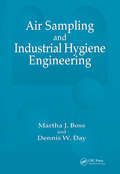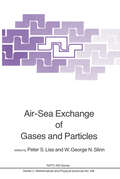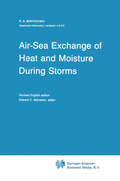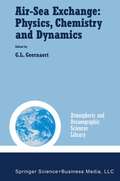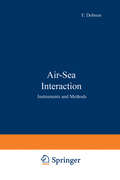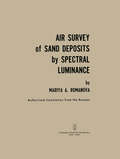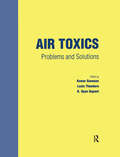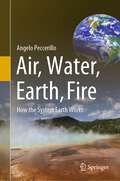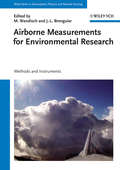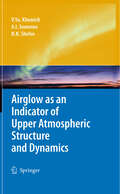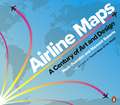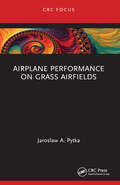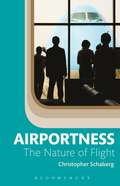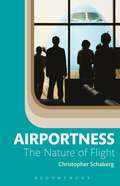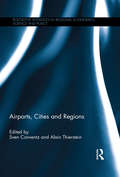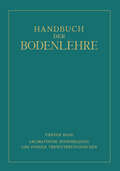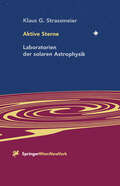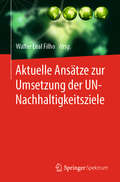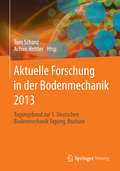- Table View
- List View
Air Sampling and Industrial Hygiene Engineering
by Martha J. Boss Dennis W. DayWe know certain chemicals cause problems in the workplace. The issues now are: Where do they occur in the workplace? How can we best evaluate them? What are the procedures for dealing with them safely? Many books simply define the problem and tell you that you need a program. Air Sampling and Industrial Hygiene gives you a guide to air sampling protocols from start to finish. The book presents sampling technology updated with today's tools - such as microcircuitry and remote sensing. The authors emphasize an interdisciplinary approach to understanding how air monitoring can adequately report current environmental conditions associated with outdoor media, indoor remediation efforts, proximal equipment, interior line monitoring, and the interrelationship of ventilation parameters. In addition to providing the how-tos of sampling, this guide covers the basics of chemical risk assessment, biological assessment, engineering evaluation of mechanical system design criteria, and chemical or process engineering hazard assessments. It presents the information using text, text outlines, graphics, and pictures - including cross sections of instrumentation and side bars to elaborate on complex concepts.Faulty readings caused by poor sampling techniques can be very costly. This book provides the how-tos for making design engineering and on-site decisions as to instrumentation selection and scheduled usage. Air Sampling and Industrial Hygiene Engineering will allow you to complete the sampling process systematically and correctly from initial suspicions to the use of obtained results.
Air Sampling and Industrial Hygiene Engineering
by Martha J. Boss Dennis W. DayWe know certain chemicals cause problems in the workplace. The issues now are: Where do they occur in the workplace? How can we best evaluate them? What are the procedures for dealing with them safely? Many books simply define the problem and tell you that you need a program. Air Sampling and Industrial Hygiene gives you a guide to air sampling protocols from start to finish. The book presents sampling technology updated with today's tools - such as microcircuitry and remote sensing. The authors emphasize an interdisciplinary approach to understanding how air monitoring can adequately report current environmental conditions associated with outdoor media, indoor remediation efforts, proximal equipment, interior line monitoring, and the interrelationship of ventilation parameters. In addition to providing the how-tos of sampling, this guide covers the basics of chemical risk assessment, biological assessment, engineering evaluation of mechanical system design criteria, and chemical or process engineering hazard assessments. It presents the information using text, text outlines, graphics, and pictures - including cross sections of instrumentation and side bars to elaborate on complex concepts.Faulty readings caused by poor sampling techniques can be very costly. This book provides the how-tos for making design engineering and on-site decisions as to instrumentation selection and scheduled usage. Air Sampling and Industrial Hygiene Engineering will allow you to complete the sampling process systematically and correctly from initial suspicions to the use of obtained results.
Air-Sea Exchange of Gases and Particles (Nato Science Series C: #108)
by P. S. Liss W. G. N. SlinnProceedings of the NATO Advanced Study Institute, Durham, New Hampshire, U.S.A., July 19-30, 1982
Air-Sea Exchange of Heat and Moisture During Storms (Atmospheric and Oceanographic Sciences Library #10)
by R.S. BortkovskiiScientists investigating the interaction between the ocean and the atmosphere now believe that the drag coefficient, and the coefficients of heat transfer and moisture transfer at the sea surface, all increase with an intensification of the wind, reaching high values during a storm. This belief is based on the results of gradient and eddy correlation measurements in the air layer over the water, as weIl as on data concerning the effect of storms on the structure of the upper layer of the ocean and on the planetary atmospheric boundary layer. However, until recently it was impossible to explain just how the above coefficients depend on the wind velocity and to extrapolate this dependence into the region of hurricane velocities. Only by studying nonturbulent mechanisms of transfer, which play an important role dose to the surface of a stormy sea, and mechanisms of spray mediated transfer in particular, was it possible to proceed to a solution of this problem. This book presents the results of laboratory and field studies of the spray field in the air layer above the surface of a stormy sea. Since there is a dose correlation between the generation of spray and the breaking of wind waves, considerable attention is given to the analysis of data on the sea state during a storm. Su'ch data are of interest when solving a number of diverse theoretical and applied problems.
Air-Sea Exchange: Physics, Chemistry and Dynamics (Atmospheric and Oceanographic Sciences Library #20)
by G. L. GeernaertDuring the 1980's a wealth of information was reported from field and laboratory experiments in order to validate andlor modify various aspects of the surface layer Monin-Obukhov (M-O) similarity theory for use over the sea, and to introduce and test new concepts related to high resolution flux magnitudes and variabilities. For example, data from various field experiments conducted on the North Sea, Lake Ontario, and the Atlantic experiments, among others, yielded information on the dependence of the flux coefficients on wave state. In all field projects, the usual criteria for satisfying M-O similarity were applied. The assumptions of stationarity and homogeneity was assumed to be relevant over both small and large scales. In addition, the properties of the outer layer were assumed to be "correlated" with properties of the surface layer. These assumptions generally required that data were averaged for spatial footprints representing scales greater than 25 km (or typically 30 minutes or longer for typical windspeeds). While more and more data became available over the years, and the technology applied was more reliable, robust, and durable, the flux coefficients and other turbulent parameters still exhibited significant unexplained scatter. Since the scatter did not show sufficient reduction over the years to meet customer needs, in spite of improved technology and heavy financial investments, one could only conclude that perhaps the use of similarity theory contained too many simplifications when applied to environments which were more complicated than previously thought.
Air-Sea Interaction: Instruments and Methods
by F. Dobson L. Hasse R. DavisDuring the past decade, man's centuries-old interest in marine me teorology and oceanography has broadened. Ocean and atmosphere are now treated as coupled parts of one system; the resulting interest in air-sea interaction problems has led to a rapid growth in the sophistication of instruments and measurement techniques. This book has been designed as a reference text which describes, albng with the instruments themselves, the accumulated practical experi ence of experts engaged in field observations of air-sea interac tions. It is meant to supplement rather than replace manuals on standard routine observations or instnunentation handbooks. At the inception a textbook was planned, which would contain only well tested methods and instruments. It was quickly discovered that for the book to be useful many devices and techniques would have to be included which are still evolving rapidly. The reader is therefore cautioned to take nothing in these pages for granted. Certainly, every contributor is an expert, but while some are back ed up by generations of published work, others are pioneers. The choice of topics, of course, is debatable. The types of observa tions included are not exhaustive and topics such as marine aero sols and radio-tracers are omitted, as was the general subject of remote sensing, which was felt to be too broad and evol ving too rapidly. The guideline adopted in limiting size was maximum use fulness to 'a trained experimentalist new to the field'.
Air Survey of Sand Deposits by Spectral Luminance
by Mariya A. RomanovaThis book gives an account of a method of determining the type composition of sandy deposits from the air by the nature of their reflection of radiant energy. The measured spectral luminance of a rock outcrop rela ti ve to the luminance of a standard is the basic property considered in this method. The spectral luminance factors p\ are measured by means of special instruments - a universal photometer, cinespectrograph, spectro visors, and other spectrometers. The measured values of P" of the investigated rocks are interpreted geologically with the aid of some methods of mathematical statistics so that a means of lithological mapping of sandy deposits from the air can be found. The importance of developing a method of determining the type composition of rocks, primarily sandy de posits, from the air stems from the extensive occurrence of deserts on the earth's surface. Sandy deserts occupy vast areas in the southern latitudes of the USSR and occur in western and central China, Pakistan, Iran, India, and other states. In these deserts there are numerous deposits of petroleum and gas, and a search for water is continuously in progress. Successful prospecting for the above minerals depends on a determination of the material composition of the sandy deposits in these deserts and the solution of several questions of recent tec tonics, paleogeography, and quaternary geology, the answers to which might also be given by a study of the dis tribution of lithological types of sands.
Air Toxics: Problems and Solutions
by Kumar GanesanThis timely new workbook is the result of a year-long effort by a group of university professors who first met at Montana Tech during the summer of 1994 for a college faculty workshop. The workshop was funded by the National Science Foundation's support for those faculty developing courses in the newly emerging field of air toxics. Part I of the book contains over 100 problems dealing with a variety of topics in this area. Part II provides detailed solutions. The problems and solutions provided will become a useful resource for the training of engineers and scientists who are or soon will be working in the field.
Air Toxics: Problems and Solutions
by Kumar GanesanThis timely new workbook is the result of a year-long effort by a group of university professors who first met at Montana Tech during the summer of 1994 for a college faculty workshop. The workshop was funded by the National Science Foundation's support for those faculty developing courses in the newly emerging field of air toxics. Part I of the book contains over 100 problems dealing with a variety of topics in this area. Part II provides detailed solutions. The problems and solutions provided will become a useful resource for the training of engineers and scientists who are or soon will be working in the field.
Air, Water and Soil Quality Modelling for Risk and Impact Assessment (Nato Security through Science Series C:)
by Adolf Ebel Teimuraz DavitashviliThis book contains the proceedings of the NATO Advanced Research Workshop on Air, Water and Soil Quality Modelling for Risk and Impact Assessment. The aim of the workshop was to further joint environmental compartment modelling and applications of control theory to environmental management. It provides an overview of ongoing research in this field regarding assessment of environmental risks and impacts.
Air, Water, Earth, Fire: How the System Earth Works
by Angelo PeccerilloThe book describes the structure, composition and evolution of the Earth, the main geological processes occurring on it, and how some crucial environmental matters that are amply debated in the media (e.g. pollution, greenhouse effect) can be fully understood by placing them in the holistic context of the system Earth as a whole. It provides basic information on a series of key geological issues, from the structure and composition of the Earth to the large-scale processes that characterize our planet, such as rock alteration and sedimentation, magmatism, geomagnetism, seismicity, plate tectonics, cyclical migration of chemical elements through various Earth reservoirs (Geochemical Cycles), and evolution of the planet from Hadean to present. It intends to reach a wide readership, which is interested in our planet and wish to have a general and comprehensive view of its origin, evolution and activity. Potential readership includes undergraduate and advanced undergraduate students in Geology and other scientific disciplines, and any moderately- to well-educated people interested in the surrounding world and eager to gain a basic knowledge of the Earth and to reach an integrated view of how our planet is working.
Airborne Measurements for Environmental Research: Methods and Instruments (Wiley Series in Atmospheric Physics and Remote Sensing)
by Manfred Wendisch Jean-Louis BrenguierThis first comprehensive review of airborne measurement principles covers all atmospheric components and surface parameters. It describes the common techniques to characterize aerosol particles and cloud/precipitation elements, while also explaining radiation quantities and pertinent hyperspectral and active remote sensing measurement techniques along the way. As a result, the major principles of operation are introduced and exemplified using specific instruments, treating both classic and emerging measurement techniques. The two editors head an international community of eminent scientists, all of them accepted and experienced specialists in their field, who help readers to understand specific problems related to airborne research, such as immanent uncertainties and limitations. They also provide guidance on the suitability of instruments to measure certain parameters and to select the correct type of device. While primarily intended for climate, geophysical and atmospheric researchers, its relevance to solar system objects makes this work equally appealing to astronomers studying atmospheres of solar system bodies with telescopes and space probes.
Airborne Measurements for Environmental Research: Methods and Instruments (Wiley Series in Atmospheric Physics and Remote Sensing)
by Manfred Wendisch Jean-Louis BrenguierThis first comprehensive review of airborne measurement principles covers all atmospheric components and surface parameters. It describes the common techniques to characterize aerosol particles and cloud/precipitation elements, while also explaining radiation quantities and pertinent hyperspectral and active remote sensing measurement techniques along the way. As a result, the major principles of operation are introduced and exemplified using specific instruments, treating both classic and emerging measurement techniques. The two editors head an international community of eminent scientists, all of them accepted and experienced specialists in their field, who help readers to understand specific problems related to airborne research, such as immanent uncertainties and limitations. They also provide guidance on the suitability of instruments to measure certain parameters and to select the correct type of device. While primarily intended for climate, geophysical and atmospheric researchers, its relevance to solar system objects makes this work equally appealing to astronomers studying atmospheres of solar system bodies with telescopes and space probes.
Airglow as an Indicator of Upper Atmospheric Structure and Dynamics
by Vladislav Yu Khomich Anatoly I. Semenov Nicolay N. ShefovThe book summarizes international progress over the last few decades in upper atmosphere airglow research. Measurement methods, theoretical concepts and empirical models of a wide spectrum of upper atmospheric emissions and their variability are considered. The book contains a detailed bibliography of studies related to the upper atmosphere airglow. Readers will also benefit from a lot of useful information on emission characteristics and its formation processes found the book.
Airline Maps: A Century of Art and Design
by Mark Ovenden Maxwell RobertsIn this gorgeously illustrated collection of airline route maps, Mark Ovenden and Maxwell Roberts look to the skies and transport readers to another time. Hundreds of images span a century of passenger flight, from the rudimentary trajectory of routes to the most intricately detailed birds-eye views of the land to be flown over. Advertisements for the first scheduled commercial passenger flights featured only a few destinations, with stunning views of the countryside and graphics of biplanes. As aviation took off, speed and mileage were trumpeted on bold posters featuring busy routes. Major airlines produced highly stylized illustrations of their global presence, establishing now-classic brands. With trendy and forward-looking designs, cartographers celebrated the coming together of different cultures and made the earth look ever smaller. Eventually, fleets got bigger and routes multiplied, and graphic designers have found creative new ways to display huge amounts of information. Airline hubs bring their own cultural mark and advertise their plentiful destination options. Innovative maps depict our busy world with webs of overlapping routes and networks of low-cost city-to-city hopping. But though flying has become more commonplace, Ovenden and Roberts remind us that early air travel was a glamorous affair for good reason. Airline Maps is a celebration of graphic design, cartographic skills and clever marketing, and a visual feast that reminds us to enjoy the journey as much as the destination.
Airplane Performance on Grass Airfields
by Jaroslaw A. PytkaAirplane Performance on Grass Airfields presents an experiment-based approach to analysis and flight testing of airfield performance on grass runways. It discusses improvements for operations efficiency and safety of these airfields. The book analyzes the interaction between the landing gear wheels and the surface of a grass runways during both takeoff and landing. Considering the ground performance of an aircraft on a grass runway, the book covers test methods and devices for measuring performance and introduces an information system for the surface condition of grass airfields: GARFIELD. The system is based on a tire-grass interaction model and uses digital soil maps, as well as current meteorological data obtained from a weather server. The book is intended for researchers and practicing engineers in the fields of aviation and aircraft safety and performance.
Airplane Performance on Grass Airfields
by Jaroslaw A. PytkaAirplane Performance on Grass Airfields presents an experiment-based approach to analysis and flight testing of airfield performance on grass runways. It discusses improvements for operations efficiency and safety of these airfields. The book analyzes the interaction between the landing gear wheels and the surface of a grass runways during both takeoff and landing. Considering the ground performance of an aircraft on a grass runway, the book covers test methods and devices for measuring performance and introduces an information system for the surface condition of grass airfields: GARFIELD. The system is based on a tire-grass interaction model and uses digital soil maps, as well as current meteorological data obtained from a weather server. The book is intended for researchers and practicing engineers in the fields of aviation and aircraft safety and performance.
Airportness: The Nature of Flight
by Christopher SchabergAirportness takes the reader on a single day's journey through all the routines and stages of an ordinary flight. From curbside to baggage, and pondering the minutes and hours of sitting in between, Christopher Schaberg contemplates the mundane world of commercial aviation to discover "the nature of flight.†? For Schaberg this means hearing planes in the sky, recognizing airline symbols in unlikely places, and navigating the various zones of transit from sliding doors, to jet bridge, to lavatory. It is an ongoing, swarming ecosystem that unfolds each day as we fly, get stranded, and arrive at our destinations. Airportness turns out to be more than just architecture and design elements-rather, it is all the rumble and buzz of flight, the tedium of travel as well as the feelings of uplift.
Airportness: The Nature of Flight
by Christopher SchabergAirportness takes the reader on a single day's journey through all the routines and stages of an ordinary flight. From curbside to baggage, and pondering the minutes and hours of sitting in between, Christopher Schaberg contemplates the mundane world of commercial aviation to discover “the nature of flight.” For Schaberg this means hearing planes in the sky, recognizing airline symbols in unlikely places, and navigating the various zones of transit from sliding doors, to jet bridge, to lavatory. It is an ongoing, swarming ecosystem that unfolds each day as we fly, get stranded, and arrive at our destinations. Airportness turns out to be more than just architecture and design elements-rather, it is all the rumble and buzz of flight, the tedium of travel as well as the feelings of uplift.
Airports, Cities and Regions (Routledge Advances in Regional Economics, Science and Policy)
by Sven Conventz Alain ThiersteinSince the emergence of urban systems, cities have developed in a mutually inter-dependent process of socio-economic dynamics and transportation linkages. In recent years, Airports worldwide have stepped beyond the stage of being pure infrastructure facilities while the complex dynamics that are taking place at and around international airports represent a crucial element in the post-industrial reorganisation of urban and regional systems. Airports are increasingly recognized as general urban activity centres; that is, key assets for cities and regions as economic generators and catalysts of investment in addition to being critical components of efficient city infrastructure. This book brings together contributions from renowned academic scholars and world leading practitioners to discuss insights gained from theory and practice. The first collection of papers reflects upon the general role and future of airports as well as their specific contribution to competitive advantages within a fast changing business and economic landscape. The second group of contributions ask about the role airports play within the innovation process that is inherently centred on generating and sharing knowledge. The third section of papers investigates the drivers of real estate developments on airport land and in the close vicinity of airports.
Airports, Cities and Regions (Routledge Advances in Regional Economics, Science and Policy)
by Sven Conventz Alain ThiersteinSince the emergence of urban systems, cities have developed in a mutually inter-dependent process of socio-economic dynamics and transportation linkages. In recent years, Airports worldwide have stepped beyond the stage of being pure infrastructure facilities while the complex dynamics that are taking place at and around international airports represent a crucial element in the post-industrial reorganisation of urban and regional systems. Airports are increasingly recognized as general urban activity centres; that is, key assets for cities and regions as economic generators and catalysts of investment in addition to being critical components of efficient city infrastructure. This book brings together contributions from renowned academic scholars and world leading practitioners to discuss insights gained from theory and practice. The first collection of papers reflects upon the general role and future of airports as well as their specific contribution to competitive advantages within a fast changing business and economic landscape. The second group of contributions ask about the role airports play within the innovation process that is inherently centred on generating and sharing knowledge. The third section of papers investigates the drivers of real estate developments on airport land and in the close vicinity of airports.
Aklimatische Bodenbildung und Fossile Verwitterungsdecken
by Edwin Blanck Fritz Giesecke Hermann HarrassowitzDieser Buchtitel ist Teil des Digitalisierungsprojekts Springer Book Archives mit Publikationen, die seit den Anfängen des Verlags von 1842 erschienen sind. Der Verlag stellt mit diesem Archiv Quellen für die historische wie auch die disziplingeschichtliche Forschung zur Verfügung, die jeweils im historischen Kontext betrachtet werden müssen. Dieser Titel erschien in der Zeit vor 1945 und wird daher in seiner zeittypischen politisch-ideologischen Ausrichtung vom Verlag nicht beworben.
Aktive Sterne: Laboratorien der solaren Astrophysik
by Klaus G. StrassmeierDie Sonne ist ein ziemlich durchschnittlicher Stern, der sich vor allem durch seine geringe Entfernung zur Erde auszeichnet. Bei näherer Betrachtung entpuppt sich die Sonnenoberfläche jedoch als wahrer "Hexenkessel" mit Magnetfeldern aller Art, Sonnenflecken, Plasmaeruptionen und plötzlichen Explosionen, die alle einen fundamentalen Einfluß auf unseren Planeten haben, einen Einfluß, den wir erst mit modernster Astronomie messen und verstehen gelernt haben. Dieses Buch erklärt die spannenden Innenwelten, die physikalischen Grundlagen und Funktionsweisen der Sonne und der anderen aktiven Sterne. Die aktuellsten Forschungsergebnisse und neuestes Datenmaterial werden fundiert, aber auch für Laien verständlich, aufbereitet und mit über 200 Bildern, teilweise Aufnahmen mit dem Hubble Weltraumteleskop, illustriert.
Aktuelle Ansätze zur Umsetzung der UN-Nachhaltigkeitsziele
by Walter Leal FilhoDas Buch befasst sich mit den Themen Nachhaltigkeit und Nachhaltigkeitsziele der UN. Obwohl letztere schon 2015 verabschiedet wurden und die Umsetzung bis 2030 abgeschlossen sein soll, herrscht gegenwärtig noch immer ein Mangel an Initiativen, die die Nachhaltigkeitsziele zum Thema haben. Das Buch stößt eine Diskussion darüber an, wie das Thema Nachhaltigkeit ganzheitlich in der Lehre, Forschung, Wirtschaft und Gesellschaft eingeführt und bearbeitet werden kann. Eine Vielzahl unterschiedlicher Disziplinen, von den Sozial- und Wirtschaftswissenschaften über Mode- und Kunst- sowie Umweltwissenschaften bis hin zu den Sprach- und Medienwissenschaften tragen zu dem Werk bei. Im Fokus des Buchs stehen die Mittel und Wege, mit denen das Engagement der Hochschulen und Nichtregierungsorganisationen in den globalen Bemühungen zur Umsetzung der Nachhaltigkeitsziele zusammengeführt wird. Der Band vereinigt viele Erfahrungen und Fallstudien, die zur Weiterentwicklung des Themas „Umsetzung der SDGs“ beitragen.
Aktuelle Forschung in der Bodenmechanik 2013: Tagungsband zur 1. Deutschen Bodenmechanik Tagung, Bochum
by Tom Schanz Achim HettlerDie Deutsche Bodenmechanik Tagung hat sich zum Ziel gesetzt, der nationalen Bodenmechanik in ihrer Vielfalt ein Forum zum fachlichen Austausch und zur Diskussion aktueller Fragestellungen zu schaffen. Der vorliegende erste Tagungsband beinhaltet die Fachbeiträge zu den Schwerpunktthemen „Weiche Böden und Konsolidation“, „Grenzzustand der Tragfähigkeit“ und „Grenzzustände bei zyklischer Belastung“. Die Tagung wurde vom Lehrstuhl für Grundbau, Boden- und Felsmechanik der Ruhr-Universität Bochum in Kooperation mit dem Lehrstuhl Baugrund-Grundbau der TU Dortmund veranstaltet. Sie fand unter der Schirmherrschaft der Deutschen Gesellschaft für Geotechnik (DGGT) an der Ruhr- Universität in Bochum statt.
